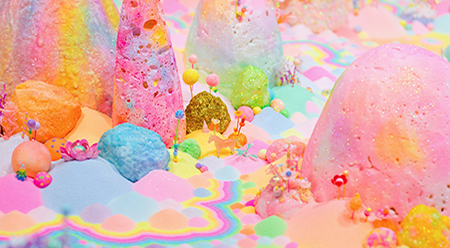 You walk into Pip & Pop‘s new Perth exhibit as a giant would in an Adventure Time cake-based utopia sprinkled with glittery fluorescent unicorn crack. Floating in PICA’s voluminous open gallery until Christmas, When Happiness Ruled is an undulating sweetscape of perky hills and swivelling mountains, raised inches from the floor on a table of meandering contours, supported by at least two dozen stout little legs.
You walk into Pip & Pop‘s new Perth exhibit as a giant would in an Adventure Time cake-based utopia sprinkled with glittery fluorescent unicorn crack. Floating in PICA’s voluminous open gallery until Christmas, When Happiness Ruled is an undulating sweetscape of perky hills and swivelling mountains, raised inches from the floor on a table of meandering contours, supported by at least two dozen stout little legs.
450 kilograms of sugar went into the making, and comprising the palette of this crystalline dream, 130 super-saturated pastel shades. Though on a larger scale the gradient is nuanced – a subtle wash from green to pink across the terrain- up close, things bustle with an intensity somewhere between euphoric and sickening. Bunches of crimped threads cascade in miniature down slopes (and with a certain dark, creeping certainty, one thinks of a hundred toy ponies, recently shorn of their tails). Adorably kitsch, stalk-like plants make sprightly eruptions amidst the vegetation.
Here and there, incongruous totems and creatures can be spotted: a cyclopean eye lodging into the side of a parti-colour knoll; a corncob putting up shop at the foot of an encrusted, bulging meringue boulderstone; a ghost, bought from a vendor in Mexico, entrapped in a rainbowed candy ring; and mooching beside a sorbet outcropping, an apple man – a cheap memento from Hong Kong. In the outer regions, curious shaggy robots roam like functionless roombas – but whether they are exiles or guardians, who could say.
It is almost too much. And it is with this ‘almost’ that Tanya Schultz – the Perth-based artist behind the Pip & Pop alias – is obsessed. Where lies the boundary between satiation and excess, sweet and saccharine? How capable are we of calibrating our own lust? Can we only ever be deceived by our desires? Can our phenomenological ken of what lies beyond be trusted, or is it all just a mirage?
Schultz herself could be thought of the mischievous sprite that orchestrated this illusory realm into being – both out of wilful artistic caprice, and to teach us all a lesson. She presents us with a sumptuous land which we cannot consume except in colour and surface texture; overwhelms us with a dream of “everything we want and more” to the point of inordinate excess; and gives us the image of an fleeting and unreal world we would not only destroy if we tried to inhabit, but would grow impossibly bored and lonely in if we did.
Appearing at an artist talk at the PICA gallery on Saturday (26 November), Schultz talked of the pan-cultural folk tales that inspire her work, which has been exhibited in galleries from Amsterdam to Tokyo to (next up) Dubai. She finds particular enchantment with those tales featuring lands that “may exist, or maybe not” – from the Japanese 421 AD fable The Peach Blossom Spring – which tells of a transient idyllic refuge that can be discovered and departed only once, to the old German story (which, somewhat ironically, I am unable to trace), which has as its hero a man who can only reach the land of his dreams if he eats a very large quantity of pudding.
Trembling at the fey, liminal space of magical possibility, immersed in the timeless, universal themes of ontological uncertainty, When Happiness Ruled evokes the myths that sustain western consumer culture; the joys and the dangers of their bounty. One thinks of the new Netflix delivery model, where content is always ‘on-demand’, yet the scroll through the options is endless.
Because it’s a hot day, I’m also now thinking of the endless invention of new ice cream flavours (Black Walnut, Alaska Fireweed and Honey, Honey Avocado, Lobster), and the petulant, childish despair at having to choose only one (well, not Lobster). And then there is the teeming new varieties of fruit that have materialised in stores over the last century – grown in other soils and imported from other shores, or engineered in the laboratories of genetic perfectionism.
This is globalisation and technology in cahoots to set the flows of capitalism into hyperdrive: the options are in insufferable surfeit, access is unprecedented, yet the desire for something more, something better still attacks us, and with renewed ferocity. Desire, those inedible mountains remind us, can only sustain itself on its own frustration.
Of wonder-filled, intricate design, When Happiness Ruled exhibits the paradoxical overlapping of wish-fulfilment and horror, hedonism and melancholy; testing with a certain gleeful abandon the point into which the aspirational and cautionary tale collapse.
Once the show’s run ends on 24 December (in apt timing with the holiday splurge), the exhibit itself will vanish out of existence. Neither sold, nor relocated, nor bits of it handed out piecemeal, it will relinquish itself into the next, final phase of the consumer cycle: refuse. It is a perverse, frustrating, dismaying windup: and deliciously apt.
Pip & Pop: When Happiness Ruled
Perth Institute of Contemporary Arts, 51 James Street, Northbridge
Exhibition continues to 24 December 2016
Free admission
For more information, visit: www.pica.org.au or www.pipandpop.com.au for details.
Image: Pip & Pop, Rainbow Dream, 2016 (detail) – photo by Ones Production
Review: Kate Prendergast
